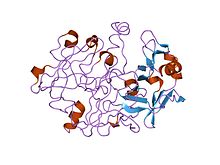Aspartic protease
| Eukaryotic aspartyl protease | |||||||||
|---|---|---|---|---|---|---|---|---|---|
 Structure of thedimericaspartic proteaseHIV proteasein white and grey, with peptidesubstratein black andactive siteaspartate side chains in red. (PDB:1KJF) | |||||||||
| Identifiers | |||||||||
| Symbol | Asp | ||||||||
| Pfam | PF00026 | ||||||||
| InterPro | IPR001461 | ||||||||
| PROSITE | PDOC00128 | ||||||||
| SCOP2 | 1mpp/SCOPe/SUPFAM | ||||||||
| OPM superfamily | 100 | ||||||||
| OPM protein | 1lyb | ||||||||
| Membranome | 315 | ||||||||
| |||||||||
Aspartic proteases(also "aspartyl proteases", "aspartic endopeptidases" ) are a catalytic type ofproteaseenzymesthat use an activated water molecule bound to one or moreaspartateresidues for catalysis of their peptide substrates. In general, they have two highly conservedaspartatesin theactive siteand are optimally active at acidicpH.Nearly all known aspartyl proteases are inhibited bypepstatin.[1]
Aspartic endopeptidasesEC3.4.23.of vertebrate, fungal and retroviral origin have been characterised.[2]More recently, aspartic endopeptidases associated with theprocessing of bacterial type 4 prepilin[3]and archaean preflagellin have been described.[4][5]
Eukaryotic aspartic proteases includepepsins,cathepsins,andrenins.They have a two-domain structure, arising from ancestral duplication.Retroviralandretrotransposonproteases (retroviral aspartyl proteases) are much smaller and appear to be homologous to a single domain of the eukaryotic aspartyl proteases. Each domain contributes a catalytic Asp residue, with an extended active site cleft localized between the two lobes of the molecule. One lobe has probably evolved from the other through a gene duplication event in the distant past. In modern-day enzymes, although the three-dimensional structures are very similar, the amino acid sequences are more divergent, except for the catalytic site motif, which is very conserved. The presence and position of disulfide bridges are other conserved features of aspartic peptidases.
Catalytic mechanism
[edit]
Aspartyl proteases are a highly specific family of proteases – they tend to cleave dipeptide bonds that have hydrophobic residues as well as a beta-methylene group. Unlikeserineorcysteine proteasesthese proteases do not form a covalent intermediate during cleavage. Proteolysis therefore occurs in a single step.
While a number of different mechanisms for aspartyl proteases have been proposed, the most widely accepted is a generalacid-base mechanisminvolving coordination of a water molecule between the two highly conservedaspartateresidues.[6][7]One aspartate activates the water by abstracting a proton, enabling the water to perform anucleophilicattack on thecarbonylcarbon of the substratescissile bond,generating atetrahedraloxyanionintermediatestabilized by hydrogen-bonding with the second aspartic acid. Rearrangement of this intermediate leads to protonation of the scissileamidewhich results in the splitting of the substrate peptide into two product peptides.
Inhibition
[edit]Pepstatinis an inhibitor of aspartate proteases.[1]
Classification
[edit]Fivesuperfamilies(clans) of aspartic proteases are known, each representing anindependent evolutionof the sameactive siteandmechanisms.Each superfamily contains severalfamilieswith similar sequences. TheMEROPSclassification systematic names these clans alphabetically.
- Clan AA (e.g.Pepsinfamily)
- Clan AC (e.g.Signal peptidase IIfamily)
- Clan AD (e.g.Presenilinfamily)
- Clan AE (e.g.GPR endopeptidasefamily)
- Clan AF (e.g.Omptinfamily)
Propeptide
[edit]| A1_Propeptide | |||||||||
|---|---|---|---|---|---|---|---|---|---|
 crystal and molecular structures of human progastricsin at 1.62 angstroms resolution | |||||||||
| Identifiers | |||||||||
| Symbol | A1_Propeptide | ||||||||
| Pfam | PF07966 | ||||||||
| InterPro | IPR012848 | ||||||||
| |||||||||
Manyeukaryoticaspartic endopeptidases (MEROPSpeptidasefamily A1) are synthesised withsignalandpropeptides.Theanimalpepsin-like endopeptidase propeptides form a distinct family of propeptides, which contain aconservedmotifapproximately 30residueslong. InpepsinogenA, the first 11 residues of the maturepepsinsequenceare displaced by residues of the propeptide. The propeptide contains twohelicesthat block theactive sitecleft, in particular theconservedAsp11 residue, in pepsin,hydrogen bondsto aconservedArg residue in the propeptide. Thishydrogen bondstabilises the propeptideconformationand is probably responsible for triggering the conversion of pepsinogen to pepsin underacidicconditions.[8][9]
Examples
[edit]Human
[edit]- BACE1,BACE2
- Cathepsin D
- Cathepsin E
- Chymosin(or "rennin" )
- Napsin-A
- Nepenthesin
- Pepsin
- Presenilin
- Renin
Human proteins containing this domain
[edit]BACE1;BACE2;CTSD;CTSE;NAPSA;PGA5;PGC;REN;
Other organisms
[edit]- HIV-1 protease– a major drug-target for treatment ofHIV
- Plasmepsin– a group of aspartyl proteases found in theMalaria-causing parasitePlasmodium
See also
[edit]References
[edit]- ^abFusek M, Mares M, Vetvicka V (2013-01-01). "Chapter 8 - Cathepsin D". In Rawlings ND, Salvesen G (eds.).Handbook of Proteolytic Enzymes(Third ed.). Academic Press. pp. 54–63.doi:10.1016/b978-0-12-382219-2.00008-9.ISBN978-0-12-382219-2.
- ^Szecsi PB (1992). "The aspartic proteases".Scandinavian Journal of Clinical and Laboratory Investigation. Supplementum.210:5–22.doi:10.3109/00365519209104650.PMID1455179.
- ^LaPointe CF, Taylor RK (January 2000)."The type 4 prepilin peptidases comprise a novel family of aspartic acid proteases".The Journal of Biological Chemistry.275(2): 1502–10.doi:10.1074/jbc.275.2.1502.PMID10625704.
- ^Ng SY, Chaban B, Jarrell KF (2006). "Archaeal flagella, bacterial flagella and type IV pili: a comparison of genes and posttranslational modifications".Journal of Molecular Microbiology and Biotechnology.11(3–5): 167–91.doi:10.1159/000094053.PMID16983194.S2CID30386932.
- ^Bardy SL, Jarrell KF (November 2003)."Cleavage of preflagellins by an aspartic acid signal peptidase is essential for flagellation in the archaeon Methanococcus voltae".Molecular Microbiology.50(4): 1339–47.doi:10.1046/j.1365-2958.2003.03758.x.PMID14622420.S2CID11913649.
- ^abSuguna K, Padlan EA, Smith CW, Carlson WD, Davies DR (October 1987)."Binding of a reduced peptide inhibitor to the aspartic proteinase from Rhizopus chinensis: implications for a mechanism of action".Proceedings of the National Academy of Sciences of the United States of America.84(20): 7009–13.Bibcode:1987PNAS...84.7009S.doi:10.1073/pnas.84.20.7009.PMC299218.PMID3313384.
- ^Brik A, Wong CH (January 2003). "HIV-1 protease: mechanism and drug discovery".Organic & Biomolecular Chemistry.1(1): 5–14.doi:10.1039/b208248a.PMID12929379.
- ^Hartsuck JA, Koelsch G, Remington SJ (May 1992). "The high-resolution crystal structure of porcine pepsinogen".Proteins.13(1): 1–25.doi:10.1002/prot.340130102.PMID1594574.S2CID43462673.
- ^Sielecki AR, Fujinaga M, Read RJ, James MN (June 1991). "Refined structure of porcine pepsinogen at 1.8 A resolution".Journal of Molecular Biology.219(4): 671–92.doi:10.1016/0022-2836(91)90664-R.PMID2056534.
External links
[edit]- TheMEROPSonline database for peptidases and their inhibitors:Aspartic Peptidases
- Aspartic+Endopeptidasesat the U.S. National Library of MedicineMedical Subject Headings(MeSH)
- MEROPS family A1
